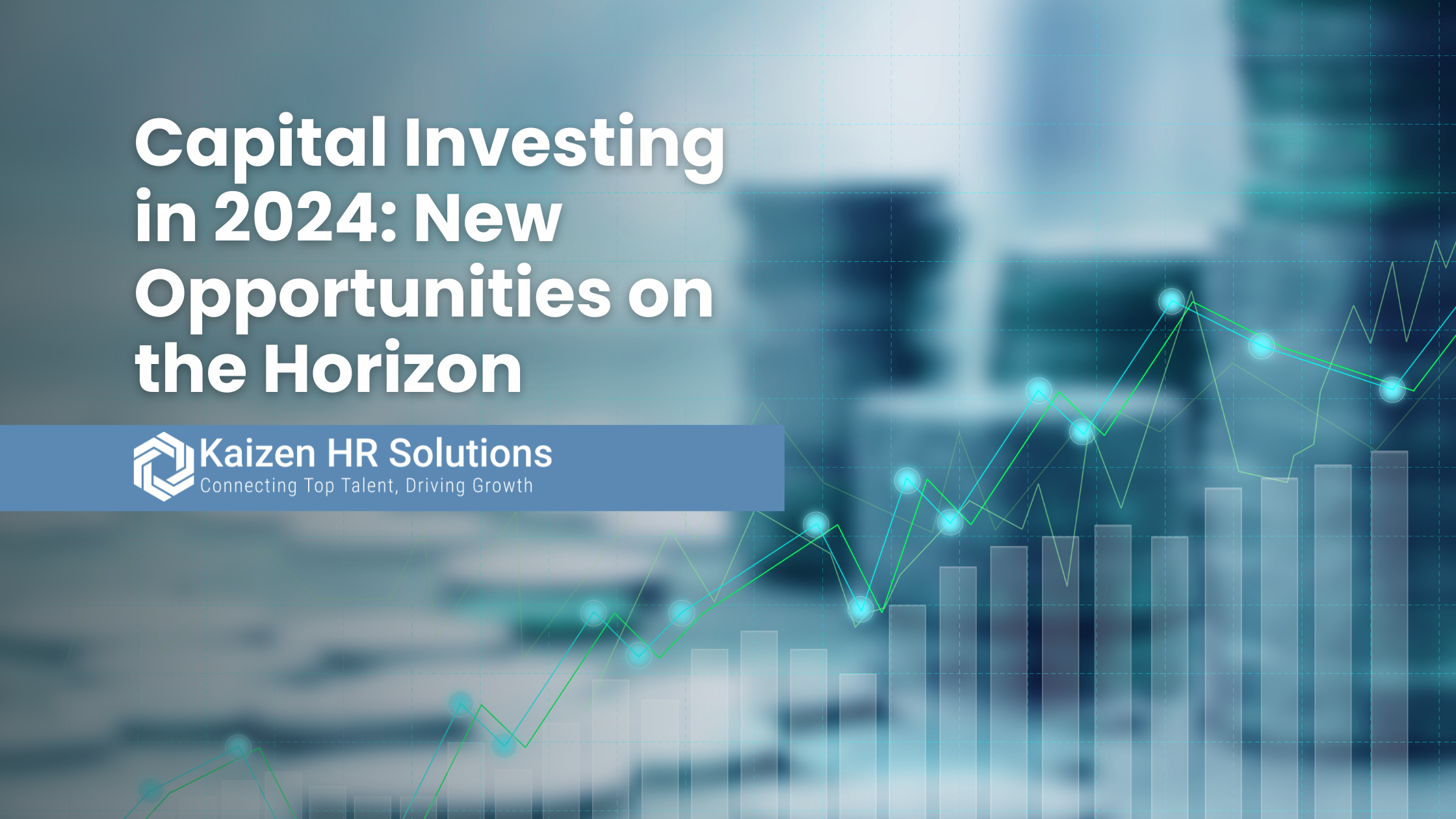Over the last few years, concerns over economic uncertainty have led to more caution and less willingness to take significant risks in investments. 2024, however, looks like it might be the year capital investing gets a major boost. Here’s what economic experts are saying, how you can be prepared, and what it means for talent acquisition.
Talent Acquisition and Capital Investing
Human capital is inextricably interwoven with capital investing; after all, employees are one of the most significant strategic assets any company has at its disposal. Decisions about where to allocate investment capital aren’t just money decisions – they’re decisions that must consider the factors necessary to attract and retain top talent. That talent acquisition budget, however, must be balanced with other capital needs, whether that’s technology, infrastructure, expansion, or others. In times of growth, having the right team in place is essential, meaning that additional investment in the people function may be necessary to support and sustain plans for growth.
Investments in talent can also impact a company’s bottom line and overall financial health. The quality of the workforce can directly impact market valuation; the presence of top talent drives innovation and productivity, which in turn makes a company more attractive to investors. Talent investments must also align with overall risk tolerance and long-term business goals, ensuring that a company’s workforce is in line with any plans to develop specific competencies, achieve particular goals, or stay aligned with the overall future direction.
The talent a company acquires can shape its culture and operational effectiveness. Investment in talent is also an investment in the company’s culture and internal capabilities, which can have long-term impacts on performance and success. As companies look ahead to 2024 and beyond, balancing talent investments with other items on the agenda will be critical to sustaining investor interest, managing competing internal demands, and driving continued growth.
A Return to Investing
Many economic analysts have a tentatively hopeful view of 2024, which is excellent news after the past few years of heavy caution. Fears of a recession have clouded outlooks over the last year or two, but experts now are pointing to a likely soft landing that avoids the worst possible outcomes. This, in turn, leads investors to be more interested in taking risks again and exploring new opportunities. In particular, the second half of 2024 will likely see more growth than the first half of the year, according to Morgan Stanley.
There is still some reluctance to invest. As Boston Consulting Group explains, “Company leaders are becoming more reluctant to actually reinvest cash flow in light of increasing uncertainty, macro-economic volatility, and growing interest rates. They risk conflicts with investors who grow impatient and want firms to invest in value-creating growth.” However, the same analysis also notes that the most successful companies are the ones getting active and making those investments; BCG’s analysis found that “companies in the top-third of stock market valuation relative to their peers—invested approximately 50% more in capex than their peers and achieved approximately 55% higher returns on assets and approximately 65% higher sales growth.”
Analysis from PwC indicates “pent-up demand for new investment opportunities and a growing backlog of companies waiting to go public… Investors have increased focus on strong business models, clear growth trajectories, and sustainable practices.” Five trends, in particular, are likely to be especially relevant in 2024 investing:
- Substantial continued investment in AI and machine learning-related technologies.
- The rise of impact investing, especially in climate change and sustainability-related technologies.
- Geographic expansion in venture investing.
- Increasing investment diversification into areas like robotics and health tech.
- The possible return of corporate venture investing.
Key Drivers of Success
Making the most of these investing opportunities requires a financial strategy that takes into account many moving parts, including financial health, risk level, and core company values. These strategies should reflect each organization’s unique needs, priorities, and values, but some overarching themes are common across industries and companies. BCG identified three key strategies common among top performers:
- “Strategic capital budgeting. Companies that exercise superior budgeting discipline invest in businesses rather than projects, translate portfolio roles into capital allocation guidelines, and strive for balanced investment portfolios.
- Investment project selection. Outperformers work to fully understand the financial profile of projects being considered. They look beyond the internal rate of return, apply criteria relevant to the investment type, and work to obtain a true understanding of potential risks.
- Investment governance. High performers apply robust governance mechanisms to choose, support, and track major investments. They address cognitive biases, establish accountability, and institute effective feedback loops.”
Having the right people making decisions and leading the way is critical to succeeding on these points and beyond. In today’s rebounding investment world, it’s more important than ever to find people with the right balance of vision and caution and who are experts in their specific markets to navigate changes as they come. Those visionary leaders are the ones who know when to take risks, when to pull back, and how to make the most of each opportunity.
Investment Outlook in the Manufacturing Sector
As reported in Deloitte’s 2024 manufacturing industry outlook, major policy initiatives have helped to spur a record level of private sector investment in the manufacturing industry, particularly in clean and sustainable sectors. For instance, Deloitte reports that “investments in semiconductor and clean technology manufacturing are nearly double the commitments made for these sectors throughout 2021, and nearly 20 times the amount allocated in 2019,” while policies like the IIJA, CHIPS, and IRA have infused manufacturing with new sources of funding and significant tax incentives to boost investing.
Two key areas of focus are common across these areas of interest and investment. First, there continues to be a growing interest in a net-zero, sustainable future, driving interest in investing in technologies linked with lower emissions, reduced waste, electrification, decarbonization, and more. Second, investors in the US are especially interested in the other half of these policy pushes: bringing manufacturing “back home” to US-based companies and workers. Investments in these areas are especially appealing as the sites of likely growth in the near future.
Capital investing will likely pick up steam in 2024, with more investors interested in taking new risks and getting on board with exciting new opportunities. For manufacturing companies – and companies across many other sectors – this represents a significant opportunity for growth and future-forward thinking, making it a critical time to seize the moment and push towards achieving key goals.
By Rose Dorta

Are you a high-performing leader or believe you have the potential to tackle a more challenging role? Would you be interested in career opportunities that are seeking these attributes?
I’d love to chat with you and answer any questions that you have. Email me, Rose Dorta, Managing Director of Kaizen HR Solutions, here.







